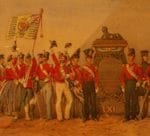The Gloucestershire Regiment
The Regularization of the Forces Act of 1871 had brought about the reorganization of recruiting and administration on a largely county basis for the British Army. The act was part of a series of reforms instigated by the Secretary of War, Edward Cardwell, which included the abolition of purchase for commissions, and improved conditions of service for the ordinary soldier. For the county of Gloucestershire this meant that the two Regular regiments, the 28th (North Gloucestershire) Regiment and the 61st (South Gloucestershire) Regiment, the county Militia battalions, and the Volunteer companies were all linked together.
In 1881, the most profound reform yet, implemented by Cardwell’s successor, Hugh Childers, created many new infantry regiments by the simple process of merging two single battalion regiments into one two battalion regiment, and adding the militia and volunteer battalions to the new regiment’s establishment. Thus the 28th and the 61st became the 1st and 2nd Battalions, The Gloucestershire Regiment. The Royal South Gloucestershire Militia became the 3rd (Militia) Battalion, The Gloucestershire Regiment, and the Royal North Gloucestershire Militia became the 4th (Militia) Battalion, The Gloucestershire Regiment; the 1st (City of Bristol) Gloucestershire Rifle Volunteers became 1st (City of Bristol) Volunteer Battalion, The Gloucestershire Regiment and the 2nd Gloucestershire Rifle Volunteers became 2nd Volunteer Battalion, The Gloucestershire Regiment.
For many old soldiers, the changes in regimental dress were as unwelcome as the changes in regimental organization. The general appearance of the late 19th century home service uniform had already been introduced several years earlier, of which the Prussian-influenced spiked helmet was the most radical new feature. But the 1881 reform brought further unwelcome changes. Attempts were made to standardize uniforms and abolish many of the unique distinctions from which the individual regiments derived so much pride. Facing colours to the scarlet jackets were now to be rationalized, with white for English and Welsh regiments, yellow for Scottish regiments, and green for Irish regiments (although all “Royal” regiments were to retain their blue facings). Thus the 28th lost their bright yellow, and the 61st lost their buff. However, unlike many regiments, both battalions were able to keep their old facings of yellow and buff respectively for their Regimental Colours, which the 1881 reform had decreed should be white with a red St George’s Cross. (In fact, although 2nd Battalion did receive the new pattern Regimental Colour, they returned it, unloved, unused and unconsecrated, and kept their old and worn buff Regimental Colour instead). Even so, in 1929 the bright yellow and buff were abandoned for a compromise colour of primrose yellow, which was henceforth to be the regimental colour of both battalions. In fact, as the years went by, many regiments were able to claw back some off the ancient distinctions that were so important to them, and the mania for uniformity in the 1881 reform was never entirely successful.
The two regular battalions of the new Gloucestershire Regiment never got out of the habit of referring to themselves as the 28th and the LXI (the 61st preferred to use Roman numerals) until they were eventually combined in 1948 as 1st Battalion.
Perhaps the most difficult change of all for the Gloucestershire Regiment in 1881 was what to do about the Back Badge, worn by the 28th since Alexandria, (the earliest known illustration of it dating to 1803). The Back Badge had the number “28” incorporated into its design. With the amalgamation, the 28th did not want to lose the Back Badge, and the 61st did not want to wear it at all. But the 61st relented, the “28” was dropped from the design and, because both regiments had always been entitled to wear the “Sphinx and Egypt” devices since after 1801, a new Back Badge was designed.
The War Office made their decision in a letter from Horse Guards on 11th August 1881:-
“Sir,
“With reference to previous correspondence I have now the honor by desire of H.R.H. the Field Marshal Commanding-in-chief to acquaint you that the “First” and “Second” battalions of the Gloucestershire Regiment will wear the Regimental Badge “the Sphinx” on the back of the Helmets instead of the number as hitherto worn in the First Battalion late 28th Regiment.
I have &c.
Blundell, Assistant Adjutant General”
Picture: Photomontage, 28th & LXI, by A.C. Lovett.


